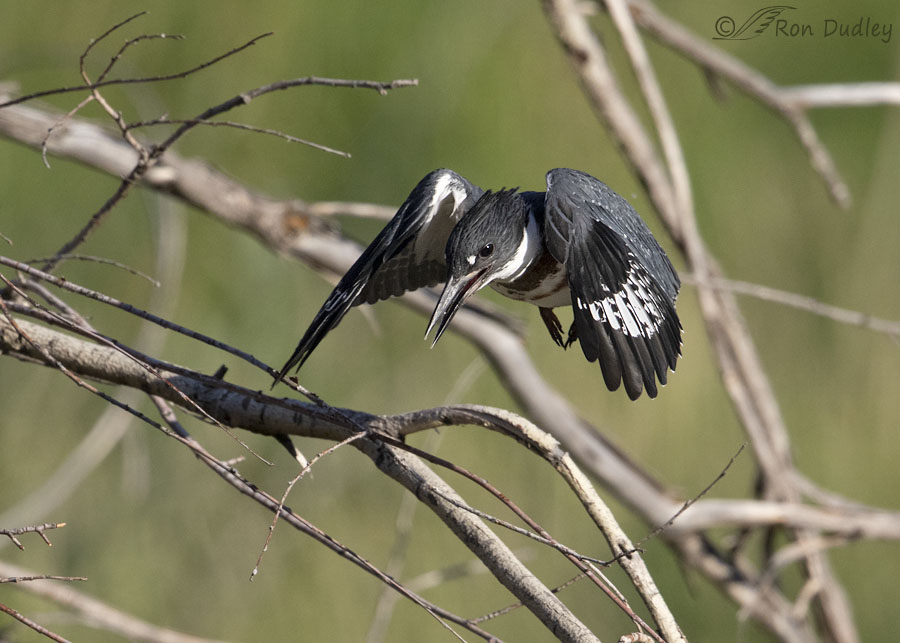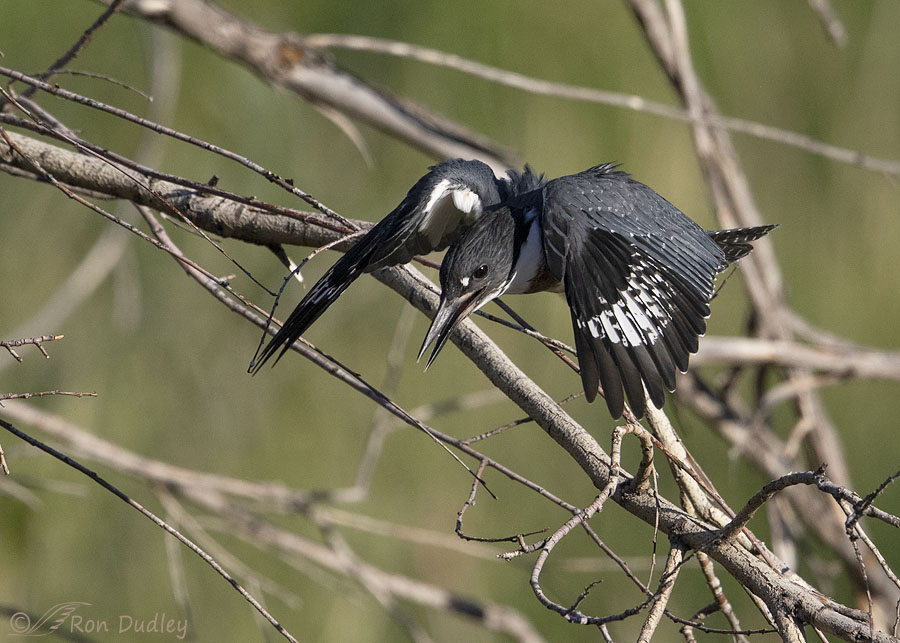The first flight sequence was anticipated and planned for but getting the second kingfisher in flight was nothing but reflexes and pure dumb luck.
The adult male Kingfisher I’ve been photographing the last few months has finally brought some of his kids to the area. There are at least two young juveniles, possibly three. Strangely I’ve never seen the adult female, not a single time and I’ve been watching for her..

1/4000, f/6.3, ISO 800, Canon 7D Mark II, Canon EF 500mm f/4L IS II USM + EF 1.4 III Extender, not baited, set up or called in
This is one of the juveniles soon after ‘he’ took off from the curved branch directly below him. The setting is so cluttered with branches and twigs I had little hope for a perched shot I like so I anticipated and planned for takeoff. This time things worked out because I quite like the photo, despite the clutter.

1/5000, f/6.3, ISO 800, Canon 7D Mark II, Canon EF 500mm f/4L IS II USM + EF 1.4 III Extender, not baited, set up or called in
This is the next shot in the burst and I like this one even more. The flight posture is very similar in both shots but I’m including them both, mainly because I’m tickled to get them both sharp. Because the kingfisher in the second shot is significantly closer to me and my depth of field is so narrow at this focal length (effectively 1120mm) the bird would typically be soft in the second photo.
Sometime down the road you may be seeing these two photos again because they may have helped me solve a mystery. It’s too complicated and involved to go into in this post so I’ll save it for another day.
I’m including the next photo just for the fun of it.
One of the most difficult photos for the bird photographer with a super telephoto lens is what I call a “hip shot”. Hip shots at those focal lengths are so difficult your chances of success approach zero. But when I’m in the field I can’t help attempting them just for the fun of it and because one day I just might get incredibly lucky. After all, pixels are cheap.
Hip shots as I define them are when a bird, usually in flight, doesn’t give me enough time to look through my viewfinder, locate the bird, lock focus on it and then push my shutter button. So I just point my 22″ long lens (with tc attached) in the general direction of the bird without looking through my viewfinder and hope I get the bird in frame and sharp.
Think of it as being similar to firing a rifle from your hip without raising it to your eye or aiming at your target, complicated by the fact that you not only have to hit your target, you have to lock focus on it first. Chances of success are virtually nil, especially with a bird in flight.
But only seconds after the photos above were taken I came very, very close.

1/2000, f/6.3, ISO 800, Canon 7D Mark II, Canon EF 500mm f/4L IS II USM + EF 1.4 III Extender, not baited, set up or called in
I spotted one of the juveniles coming in from my left to land on an old stump below me. If I was going to get ‘him’ in flight or during landing I had no time to locate him in my viewfinder so I attempted a hip shot as defined above. I just pointed my lens and pulled the trigger.
I was flabbergasted when I saw that I almost succeeded. The young kingfisher was centered in the frame and darn near sharp. I even caught him in a pre-landing pose that I like a lot. Getting him this sharp with the background so close to him only adds to the difficulty of the shot.
He isn’t quite sharp enough for me to use this photo for any purpose other than this post but getting the shot as good as I did made my day.

As an afterthought I decided to include this photo that shows where he landed. Some of the stump at the left of this photo can be seen on the right side of the previous photo.
Anyway, near successes like that with nearly impossible shots can please me almost as much as getting an easier but truly great shot. Maybe you have to be a bird photographer to understand…
Ron


Sensational series Ron! Thanks for sharing!
Charlotte Norton
That “hip” shot is fabulous! May not be up to professorial standards, but wow!
Thanks, Arwen. Except for the slight to moderate softness I like it a lot too.
I wonder why she is so camera shy. ‘Don’t look at me. I can’t do a thing with my feathers!’ at play. She/they have obviously been very busy and successful in the last little while.
Another delightful series – and your hip shot is a triumph. A rare gem.
Thanks, EC. I’m worried about her. I hope nothing happened to her so the male had to carry the extra load of raising the youngsters. In other years I’ve seen both male and female of a breeding pair at this location. Often.
I wondered about that – and hope that you see her soon.
These young’uns are making their dad proud with their mad skillz! And you have outdone yourself, kingfisher-wise, Mr. D — fabulous pics of some fabulous chicks! (Yes, I know they’re not really chicks….) Thanks for a real day-brightener!
(Yes, I know they’re not really chicks….) Thanks for a real day-brightener!
I’m glad you enjoyed them, Chris. Thank you.
Love the hip shots! Those stubby little dachshund legs in the first one and such a gleeful look, “See what I can do!” And then “I did it!” in the second.
Thank you, Ron, for such a good, positive start to the day.
“Dachshund legs” – perfect, Carolyn.
Based on the evidence, you should try more hip shots. I can’t imagine how many images of Belted Kingfishers you have stored on your computer from your years of photographing them, but in their case I don’t think you can ever get enough of a good thing.
Lyle, actually kingfishers were a nemesis of mine until just the last few years. I have very few photos of them that are about 5-6 years old or older. But you’re right about my kingfisher photos taken in recent years. There’s a bunch of them – I don’t even want to look to see how many I’ve kept.
I so appreciate your willingness to share your wisdom. I look forward to your blog and as a lifelong learner photographer, am always delighted with the new information you provide. Loved Wayne’s quote too…worthy of calligraphy!
Thank you, Kellie. Wayne’s quote hits it right on the… puck, doesn’t it.
I get it, like the saying, “you never know until you go”, this saying also applies to most of life, “you never know if you don’t try”.
Great series!
Exactly, April. Kinda like what hockey player Wayne Gretzky said, “I miss every shot I don’t take”.
Your hip shot for an amateur like me would be a good shot. These two juvenile Kingfishers are too cute. What a treat it would be to be able to be there day after day to observe and film their development.
Everett, I keep trying to figure out if there’s two juveniles or three. They’re hard to keep track of and avoid missing photo opportunities at the same time.
Now THAT’S shootin’ from the hip! Glad Dad brought the youngsters to work yesterday. Looking forward to hearing more about this mystery. *eyebrow waggle*
Glad Dad brought the youngsters to work yesterday. Looking forward to hearing more about this mystery. *eyebrow waggle*
Thanks, Marty. I’m just going to throw it out there and see what my readers think of my logic as it regards the evidence. I may be right or wrong.
I have such a limited field of view with my prime 300mm x 1×4 that I often miss getting both birds when there is a confrontation. BYW your (and admittedly my) habitual habitual use of the male pronoun can cause trouble.
“habitual use of the male pronoun can cause trouble”
I’m aware of that, Kenneth. That’s why I put it in quotes. I do mix it up sometimes and use ‘she’ but when I do that I’m challenged more often for “misidentifying” the sex.
VBG! Wonderful shots, Ron. I’d get air “shooting from the hip” and blurry air to boot!
I’d get air “shooting from the hip” and blurry air to boot!  Those stubby little legs always amaze me. Works for them!
Those stubby little legs always amaze me. Works for them!
None here this summer so far but then generally don’t see them until later in the summer for whatever reason.
“Blurry air” – love it, Judy. I’ll probably steal it for use on another post someday.
I’m not a bird photographer but can definitely appreciate your skill (and luck) in getting the penultimate shot here. And there’s something about the landing posture that really captures the athleticism of their wings, too. Kingfishers are special!
Thank you Cathy. They sure are!
I’m sure you know that the young “him” is a female. And these pictures look pretty great to me! Thanks
I guess I don’t know that for sure, Noel. Juveniles of both sexes have red on their breasts so I chose not to call it.